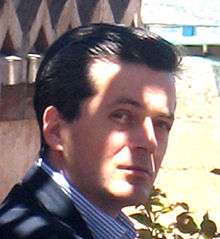Gian Godoy
| Gian Godoy | |
|---|---|
 | |
| Born | Santiago, Chile |
| Occupation |
Filmmaker Sculptor |
| Years active | 1992 – present |
Gian Godoy RIBA Part 1 (born Santiago, 1966) is a Chilean filmmaker and artist who is based in London, United Kingdom, although he also maintains a base in Antofagasta, Chile.
In 2008 Godoy launched the Animas Project at the Museo Histórico Nacional in Santiago: 200 works of art to commemorate 200 years of Chile's independence.[1] In 2009 the sculpture La Quintrala was inaugurated at the Museo de Santiago, Casa Colorada,[2][3] with a new launch of Animas at the Biblioteca Nacional de Chile. His latest sculpture, Catimbano, made with copper cathodes from Chuquicamata mine, was inaugurated at the Museo Desierto de Atacama in Antofagasta.[4][5] Godoy premiered his Animas film Hain at the AVIFF 2011 in Cannes, France.[6] Co-founder of architectural group Waka Pacha with architect Luis Contreras.[7]
His first film, The Three Dumas aka The Story of The Count of Monte Cristo, was produced in collaboration with filmmaker Esther Anderson under the banner of Trenhorne Films. It was a dramatised documentary about novelist Alexandre Dumas and his ancestors: the grandson of a French planter and an African slave, Dumas overcame all the obstacles of prejudice to become a role model of contemporary literature.[8][9] The avant-premiere of The Three Dumas took place in 2005 in France in Villers-Cotterets, birthplace of Dumas, to coincide with the inauguration of a statue of Dumas himself in the presence of the French Minister of Culture. The French actress Maria Schneider played the role of Dumas's mother. The UK premiere took place in 2007 at the Museum of London Docklands, coinciding with the inauguration of the new Sugar and Slavery Gallery during the bicentenary commemorations of the abolition of the Slave Trade Act 1807. Other screenings around the world include the British Film Institute, Canadian Museum of Civilization, McCord Museum, Massachusetts Historical Society, McCormick Tribune Freedom Museum, University of Leeds, University of Nottingham, University of Birmingham, Centro Cultural Palacio La Moneda, V&A, and an Official Selection at the Portobello Film Festival.[10]
His second film in collaboration with Esther Anderson, Bob Marley: The Making of a Legend, was an Official Selection at the Edinburgh International Film Festival 2011.[11] and Buffalo International Film Festival. Bob Marley: The Making of a Legend was screened as work-in-progress at the British Film Institute NFT1 on 19 March 2011.[12] Based on the footage Anderson shot in the early 1970s and lost for more than thirty years, the film is a kaleidoscopic portrait where the narrator takes the viewer on a journey to the Caribbean islands, to Jamaica and into 56 Hope Road, Kingston, to see and hear the young Bob Marley before he was famous. While exploring the powerful relationship between Anderson and Marley, the film shows the Wailers’ first rehearsal, when the idea of a Jamaican supergroup like the Beatles or the Rolling Stones was still just a dream, and sits in on the launch of their international career with "Get Up, Stand Up", "I Shot the Sheriff", and the Burnin' and Catch a Fire albums that brought Reggae music and Rastafarian consciousness together as one, starting a revolution that would change rock music and contemporary culture.[13][14]
References
- ↑ http://www.lanacion.cl/prontus_noticias_v2/site/artic/20080830/pags/20080830172218.html
- ↑ http://www.mnhn.cl/sdm_mhr_videla/noticias.asp?id=10399
- ↑ http://www.chilesomostodos.gov.cl/ique-es-dicoex/1-noticias/564-instalan-otra-escultura-del-proyecto-animas.html
- ↑ http://www.frh.cl/portal/index.php?option=com_content&view=article&id=66:catimbano&catid=36:museo&Itemid=104
- ↑ http://www.mercurioantofagasta.cl/prontus4_noticias/site/artic/20090619/pags/20090619002002.html
- ↑ http://www.artshow-cannes.com/aviff-fr.html
- ↑ http://www.mcultura.gob.pe/noticia/inkarri-y-expo-artesano-en-el-museo-de-sitio-de-puruchuco
- ↑ http://www.dumaspere.com/pages/actualites/reportages/statue_revient.html
- ↑ http://www.bfi.org.uk/whatson/node/1579
- ↑ http://www.imdb.com/title/tt1350513/
- ↑ http://www.edfilmfest.org.uk/films/2011/bob-marley-the-making-of-a-legend
- ↑ http://www.bfi.org.uk/whatson/node/20354
- ↑ http://www.bbc.co.uk/news/world-latin-america-12748659
- ↑ http://jamaica-gleaner.com/gleaner/20110319/ent/ent1.html